Soundproofing the ceiling in an apartment with a suspended ceiling: how to properly arrange sound insulation
Are you planning large-scale renovation work or finishing an apartment in a new building? Agree that timely soundproofing of the ceiling in an apartment under a suspended ceiling, which can provide an acceptable noise level for a comfortable life, will help maintain peace and good relations with upper neighbors.
Are you thinking about soundproofing, but don't know which option to choose? We will help you deal with this issue - the article discusses the best ways to soundproof the ceiling space.
The main stages of installation are also given with step-by-step photos, recommendations and video tips from experienced builders on how to carry out the work on their own.
The content of the article:
Do you need soundproofing for a suspended ceiling?
Have you long dreamed of installing suspended ceilings in your apartment and have you heard about the need for noise insulation work? Or do you think that these are unnecessary expenses that unscrupulous managers are trying to encourage you to make as much money as possible from the client?
Let's look at the feasibility of performing sound insulation for a suspended ceiling structure.
It is definitely needed in such situations:
- You constantly hear your neighbor swearing or talking on the phone with friends/relatives.
- At night you wake up because your neighbor has coughed or rolled over.
- You have too high ceilings in your apartment, which you want to “lower” by stretching a PVC sheet onto a frame fixed 20-25 cm below the ceiling slab.
- After installing suspended ceilings, you began to clearly hear what was going on with your upper neighbors.
Such problems can be solved by a competent sound-proofing structure (ZIK) or, as installers and ordinary users call it, Shumka.

There is a division of noise into 2 main types:
- air;
- shock.
The first includes sounds made by animals, as well as the crying and screams of children and the voices of adults. And to the second type - sounds from hitting furniture, heels, hammer drills and others.
The main task of the ZIK, mounted under a suspended ceiling, is to reduce the level of airborne noise to a comfortable level.
If you have problem neighbors who constantly drop or move furniture, or wear heels at 6 am, then such soundproofing will not help.
It will also be ineffective if the room has extremely low ceilings and there is no space for installing a good sound-absorbing layer made of several types of materials.
Even the latest and most expensive material 5-10 mm thick, alone attached under a suspended ceiling, will not be able to solve the problem of eliminating excessive audibility of extraneous sounds in the apartment.
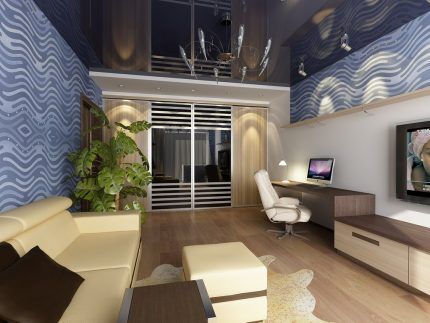
Soundproofing options
You may have heard that suspended ceilings independently cope with the problem of sound insulation - after stretching them, you will no longer listen to the news on your neighbors’ TV? This is a myth - a tension structure with PVC film or fabric alone is not capable of cutting off sounds.

But the opposite situation can very well happen - if the ceiling is fixed too low from the floor slabs, reflection of sounds can occur, the so-called “drum effect”. Similar reviews can be found many times on the Internet.
And the only solution to this problem is to dismantle the canvas, fill the space with several layers of soundproofing materials and reinstall the stretch ceiling.
Sound absorption systems perform according to frameless And frame technologies. Moreover, the latter can be carried out using vibration suspensions or according to the installation diagram self-supporting ceiling, when the frame is fastened between the walls.

You can also use the simplest option - fix sound-absorbing mineral plates and stretch a PVC sheet under them at a distance of 2 cm.
This option will allow you not to worsen your living conditions after installing suspended ceilings, avoiding the “drum effect”. But with the absorption of noise from neighbors, you will get a rather modest result.
Which technology to choose depends entirely on the characteristics of the room and the expectations of the owner.The first is convenient and easy to install, taking up little space. But to implement a frame ZIK, you will need not only experience in attaching profiles, but also more space under the ceiling.
As for installing the structure, if you have no experience in performing repairs, it is better to pay money to a company whose employees will carry out professional installation in accordance with all the rules.
After all, if the technology for laying the soundproofing cake under the tension fabric is violated, it will not work.
Brief overview of materials
To ensure reliable sound insulation of a suspended ceiling structure in an apartment, special materials will have to be used - those with sound-insulating and noise-absorbing properties.
The range on the market is very wide - there are ready-made solutions of the following types: Knauf P 131 (P 231), sandwiches made from several layers of materials of varying densities. As well as certain types of materials that can be combined at will and taking into account the allocated budget.
Let's take a closer look at the most popular materials on the market.
To install sound insulation, you will also need a vibro-acoustic sealant, a vibration-isolating gasket-tape and vibration suspensions.
A rather interesting solution attracts the attention of customers - RPG Comfort. This is a sandwich made of a wood fiber layer, expanded polystyrene foam, reinforced fiberglass mesh and a polymer-cement composition.
Despite the manufacturer's claims about wonderful soundproofing properties, these slabs must be used in conjunction with blocks produced by this company in order to obtain a partition between rooms that meets the requirements of GOST for sound insulation levels, but not ZIK.

Also, you should not choose foam plastic materials in any design - this is an excellent insulation material, which is useless when arranging sound insulation.
Acoustic engineers are no less critical of materials such as cork, polyurethane foam, polyethylene foam, and egg trays. Instead, it is advised to buy special mineral wool - which has soundproofing properties. Its thickness should be 40-50 mm, and its density should be at least 40 kg/m3.
Installation instructions for soundproofing
Having decided on the type of ZIK and the features of the installation, you have to decide: to do everything on your own or with the involvement of professional craftsmen from a company engaged in soundproofing work.
If you have experience in performing repairs, then it is quite possible to start creating a 3D structure. In this matter, it is important to choose the right materials and secure them according to the manufacturer’s instructions.
Regardless of the option chosen, it is important to prepare for the installation of the structure. Which, in order to save money, you can do on your own.
First we do electrician – if you are not an electrician, then it is better to invite a professional electrician for these purposes. After all, sound insulation and suspended ceilings are installed for at least 7-10 years, until you want to make a new renovation.
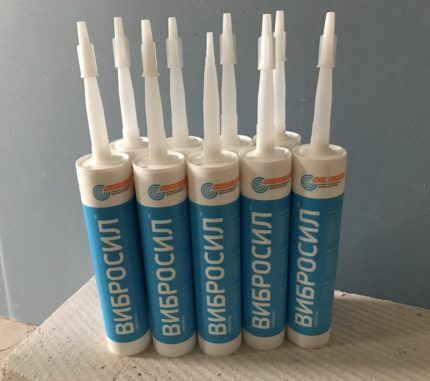
Then it is important to seal all the joints between the ceiling slabs - this work can be done independently, even without much experience.
Cement mortar can be used to seal the joints of ceiling tiles. Although sellers suggest applying expensive soundproofing sealant, the consumption of which can be quite considerable if there are significant cracks and holes in your ceiling.
Therefore, for problem areas, it is more advisable to use the “tow + mortar” design, tightly filling the holes and sealing them with mortar.
As for the sealant for processing slab joints in the future, you can use a neutral sealant instead of a special product. It is neutral, because the base of this product can be vinegar, acrylic, etc., which may turn out to be completely incompatible with metal.
When the ceiling is prepared, you can begin to construct a suitable 3D structure.
Option #1 - frame technology
If the height of the ceilings in the room allows, then it is most effective to install a frame ZIK under the tension fabric. This is a multi-layer suspended ceiling, assembled from materials of different densities, installed on a frame made of profiles.
Such a cake will not only provide decent sound insulation, but will also prevent the panel from becoming a “drum membrane”, re-emitting all the sounds coming from the ceiling.
Let's look at the step-by-step installation process in the following photo collection.
When constructing a structure, a different set of materials can be used. For example, first of all, fix it directly to the ceiling ThermoSoundIsol. This material is in bales - 14 mm fiberglass canvas. Mounts directly to the ceiling.
Then mineral slabs laid in a metal frame.After them - soundproofing panels with sand type Soundguard. This is a 3-layer corrugated cardboard with a thickness of 13 mm.
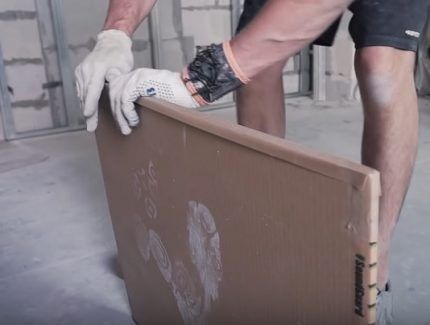
The next stage is complete sealing. All joints must be coated with vibration-proof sealant, which does not shrink. All seams and connections to the walls too.
This is necessary to get a sealed structure that will work. You can use a special tool - vibroacoustic sealant. It is applied with a spatula, evenly distributed over the joint surface, capturing the slabs, and glued on top with adhesive tape, paper.
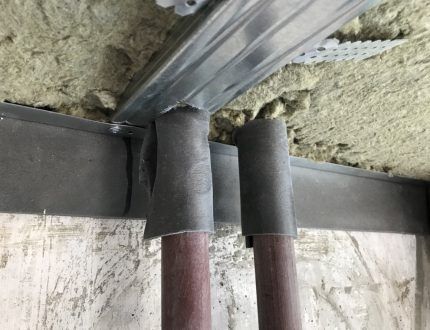
Also, when making a pie, you should use materials of varying densities, from 3, and preferably 5 layers. Only one cotton wool will give minimal effect.
After arranging the suspended ZI structure, you can mount the tension fabric, departing 2 cm from the suspended one. It is advisable to secure the frame for its installation even before the start of soundproofing work.
Option #2 - frameless method
This method requires more thorough preparation of the base, but securing the structure is a little easier. For the frameless version of ZIK you will need: a sandwich plate of the type ZIPS-III-Ultra and mounting kit included. And also a damper type Vibration stack, sealant and plasterboard sheets, or better yet gypsum plasterboard + gypsum board.
After such a cake, you can safely install a suspended ceiling made of PVC, fabric or acoustic canvas and connect light bulbs, the installation sites of which were also designed and prepared in advance. It is important to retreat 2 cm when installing the canvas, and no more, so as not to provoke a “drum effect” with too large a gap.
Option #3 - simple installation of a sound absorber
As an option, to prevent the tension fabric from becoming a drum membrane, you can use cotton wool fastening to “fungi” for noise absorption. This method will not protect against existing noise, but will prevent the improvement of audibility after installation.
It is also good to build a frame from wooden blocks or metal profiles. And then lay mineral slabs in it, additionally securing them with “fungi”. Or glue it with special glue on a gypsum/cement base.
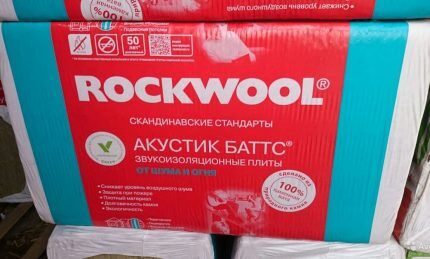
A good option is slabs ACOUSTIC BUTTS from Rockwool. This is a soundproofing dense stone wool slab. It is attached directly to the ceiling, without the use of additional layers.
You can also attach a ready-made solution such as a Knauf self-supporting ceiling as a sound absorber. For example, KNAUF P231. To install it, you will need to read the instructions and strictly follow them.
You can find advice on installing a self-adhesive membrane under a tension structure. This material is easy to attach on your own; you don’t even need to buy special glue - the manufacturer has already provided for everything.
But the effect of its installation in terms of sound insulation will be practically imperceptible. It is best to use this material in combination with others - mineral wool, for example, and sheets of drywall.
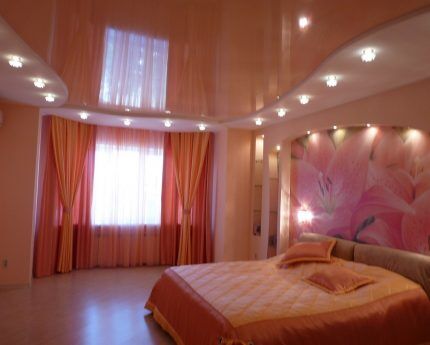
If the room has full insulation of the walls, floor, and ceiling, and the neighbor above has the flooring installed correctly, then comfortable conditions will be ensured and suspended ceilings will only please you. True, provided that all work was carried out efficiently and in accordance with technology.
Conclusions and useful video on the topic
Video about self-installation of soundproofing materials on a suspended ceiling:
Theoretical information about sound insulation and the optimal set of materials for its arrangement:
Video instructions for installing high-quality and expensive sound insulation by professional installers:
Having understood the popular materials presented on the building materials market and familiarized yourself with the main methods of sound insulation, you can make sure that the correct structure is installed under the suspended ceilings in your apartment. And if you wish and have installation experience, you can do this work yourself.
Would you like to talk about your experience in soundproofing the ceiling or supplement the above material with useful comments and recommendations? Please write comments on this article in the block below.
If you still have questions about the choice of material and want to clarify the nuances that we did not mention in this material, ask questions to our experts in the comments block.




Anyone who has encountered noisy neighbors upstairs understands better than anyone how important it is to make good soundproofing of the ceiling in an apartment. Small children with their games, pets running around the apartment, and other noises are very disturbing, and sometimes downright annoying when you want to relax in a calm environment after a hard day at work. Now I’m planning a renovation and will definitely do sound insulation. I'm sure it will all pay off with my peace of mind.
The foam still dampens the sound quite a bit. A long time ago I soundproofed the front door. There was an effect.In general, the best way out is to have strong nerves and establish normal relations with your neighbors. Purely psychology. I fall asleep just fine with the TV playing loudly, but even rustling noises on the staircase and in the neighbors’ area infuriate me. I use TV to simply mask unnecessary noise.
The apartment above is for rent, constantly new tenants and every now and then hyperactive in the evenings - music, laughter. I'm already tired of the showdown. Question: Will sound insulation completely drown out unnecessary noise or will it only reduce it? To what extent?
Hello. The sound from the neighbors above may be complex in your case - it is impact noise and airborne noise. The problem is that noise spreads not only along the ceiling, but throughout the entire structure of the building - floors, walls. Therefore, in an amicable way, a “room within a room” would be an ideal sound insulator, but such a structure will consume a lot of footage, which is impractical for apartments.
From my own experience, depending on how much square footage and amount you are willing to sacrifice, the noise level with ceiling insulation can be reduced by approximately 9 to 23 decibels. I can’t say for sure, it depends on the material of the supporting structures, partitions and ceilings, as well as the noise level from the neighboring one. The cost of the structure will be from 2 to 4 tr. per sq. meter. In this case, specialized acoustic materials should be used. Will eat from 5 cm to 20 cm respectively. What they can advise you on forums about polystyrene foam, mineral wool, and so on is ineffective.
But here you also need the personal presence of an acoustics engineer so that he can assess the noise level and choose for you the most optimal soundproofing option based on your capabilities.